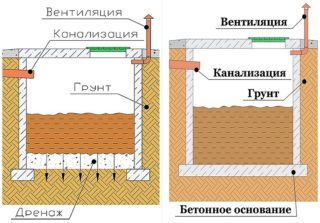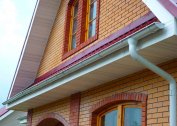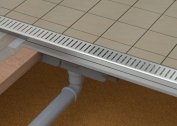The cesspool is the simplest device for the accumulation of household waste. However, its installation requires compliance with safety standards. Bacteria in wastewater can lead to poisoning or infection if they somehow enter the human body through drinking water or vegetables grown on the site.
Regulatory requirements
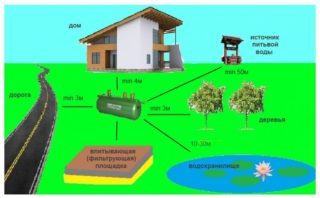 If the location and design of the septic tank is improperly selected, there is a risk of subsidence of the foundation, since constant moisture in the soil near the house deforms the building. There is a risk of a wall collapse, the restoration of which will entail high costs.
If the location and design of the septic tank is improperly selected, there is a risk of subsidence of the foundation, since constant moisture in the soil near the house deforms the building. There is a risk of a wall collapse, the restoration of which will entail high costs.
Green spaces will also suffer due to excess moisture. The absorption of certain nutrients is impaired, and the root system simply rots from the lack of oxygen. Choosing a place for the future cesspool is necessary, observing the rules:
- Do not place near sources of drinking water, especially wells, the depth of which coincides with the depth of groundwater. The artesian well is fed from other sources, so the close location of the septic tank does not harm it. A cesspool should be no closer than 30 meters from the well.
- You can not place a pit near the housing, especially if it is not tight, but has an open bottom. This also applies to storm sewers, for which concrete perforated rings are often chosen. The water in it is clean, but it can erode the foundation. A septic tank is dug at a distance of more than 5 meters from the nearest wall.
- When arranging an leaky pit, soil properties are taken into account. Sand better absorbs waste and filters them. Clay practically does not let moisture through, so on loams it is better to make the bottom closed. In this regard, you need to consult with geologists or entrust the sewerage device to professionals.
- Volume is calculated based on the number of people living in the house. On average, this figure is 150 l / day excluding a washing machine and dishwasher.
- A simple septic tank will have to be periodically pumped out and taken out, so the place should be accessible for a large sewage machine. There are options when the main storage is done at the end of the site, and the second septic tank is closer to the road. In order to pump waste, a fecal pump is installed.
- To prevent the smell of sewage from disturbing residents, a sealed cover must be provided. The concrete version skips the stench, so it’s better to buy a plastic one.
The walls of the cesspool should not allow waste to enter the soil, so they are additionally rubbed with cement mortar.
It is important to comply with these requirements also because there are special regulatory bodies that may issue a fine or require that the sewer pit in a private house be properly constructed, based on existing standards.
Types and arrangement of cesspools in private homes
 Depending on the budget, the type of cesspool is chosen:
Depending on the budget, the type of cesspool is chosen:
- The eternal septic tank. This is a single-chamber structure with an open bottom, where excess fluid is absorbed. Solid waste can be processed using bacteria-based products and used as organic fertilizer in your own area. This is not dangerous, on the contrary, it helps to increase the amount of humus in the soil. One condition is necessary - that the soil absorbs water well.
- Two or three chamber concrete pits. This is an advanced option. Solid waste is stored in the first compartment; in the second and third, the liquid is purified and absorbed into the ground. This design should rarely be cleaned and removed. On average, this happens once a year.
- Home biological treatment station.This is a more expensive facility, but the degree of purity of the outlet water reaches 98%. Such a liquid can be discharged into a body of water without harming the environment and fish. The sewage is cleaned by the activity of microorganisms that process organics. The station operates in automatic mode, but requires power consumption. Such facilities are more profitable to do with the joint efforts of several residents in order to reduce the cost of sewage.
- Plastic constructions. Purchased septic tanks are lightweight and can be installed and connected independently without the use of construction equipment.
In some cases, residents spread a sewage pit of bricks, which takes more time, and also requires sealing with cement mortar. A temporary budget option that is more suitable for a country toilet is a septic tank of car tires. In this case, one should not hope for tightness.
Design and implementation of necessary calculations
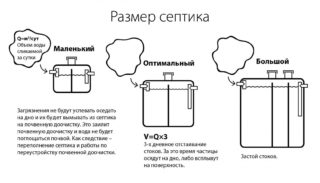 First you need to calculate how many liters of water per day the pit will take. Its volume depends on this. For example, in the house there are 3 people who spend together 450 liters per day. About 3 cubic meters per week. In a month 12 - 13 cubic meters of sewage. If you make a septic tank with a volume of 5 cubic meters with a sealed bottom, it will be necessary to pump out the waste once every two weeks. Given that the volume of the tank of the sewer machine is 4 cubic meters, the septic tank can be made a multiple of this number, that is, 4 or 8 cubes.
First you need to calculate how many liters of water per day the pit will take. Its volume depends on this. For example, in the house there are 3 people who spend together 450 liters per day. About 3 cubic meters per week. In a month 12 - 13 cubic meters of sewage. If you make a septic tank with a volume of 5 cubic meters with a sealed bottom, it will be necessary to pump out the waste once every two weeks. Given that the volume of the tank of the sewer machine is 4 cubic meters, the septic tank can be made a multiple of this number, that is, 4 or 8 cubes.
If there is an unexpected delay with disposal, the pit must be done with a margin. According to the norms, its depth cannot be more than 2.5 m, therefore it is recommended to make two containers so that the remainder flows into the next and is absorbed into the ground.
Before buying materials, they calculate how many meters of pipes it will take to equip the highway, given the slope. Then mark the area and the junction of the internal sewage system with the external one.
There should not be sharp turns and changes in height. If it is impossible to do otherwise, in such places, inspection wells are required to be installed through which you can carry out maintenance and clean the blockages.
Necessary tools and materials
Depending on what material the cesspool will be made of - light or heavy - you need to prepare tools.
In any case, you need a building level to horizontally evenly install the tank. For plastic and concrete structures will have to fill the bottom with cement mortar. It is advisable to lay down the reinforced mesh so that the movement of the soil does not damage the platform.
For heavy structures, a crane will be required during installation, and an excavator for digging a trench. Manually shoveling it will be difficult to do.
To mark the trenches, a long rope and pegs are needed to even out the boundaries of the pit.
Installation Steps
After all the preparatory measures, excavation work begins - digging a pit with a margin on the walls, concreting the bottom and installing a plastic or concrete septic tank. To make it convenient to pump out the drains, the bottom is made at an angle.
It is necessary to calculate the depth of the pit and trench for the pipe so that the inlet coincides with the pipe. Next, concrete rings are installed using options with locks or simple products. For plastic containers, it is necessary to strengthen the walls so that the soil does not damage the container. For this, the walls are poured with concrete and reinforced. As an option - a mesh of reinforcement around the tank.
Joints between concrete rings are sealed with water-repellent mortars or cement. The inlet must also be sealed so that the escaping fluid does not enter the ground.
When constructing two or three septic tanks in a row, it is necessary to ensure that the inlet pipe of the first tank is above the overflow hole in the second. The same goes for the second and third containers.
To eliminate the risk of waste entering the soil between the walls of the septic tank and the soil, a hydraulic lock is made of clay. It does not leak moisture, so it is well suited for this purpose. Wet clay is applied in a layer of about 10 cm around the container and carefully compacted. The rest of the space is covered with sand and soil.
Calculation of the layout of the device for a cesspool for a house with permanent residence and its installation within 1 - 2 days will cost the owner an average of 50 thousand rubles, taking into account consumables - concrete rings and floor slabs, manhole covers, materials for insulation.
The price also includes delivery of materials and installation. Prices may vary depending on the type of soil and installation features, as well as the distance to which the building materials must be delivered.
